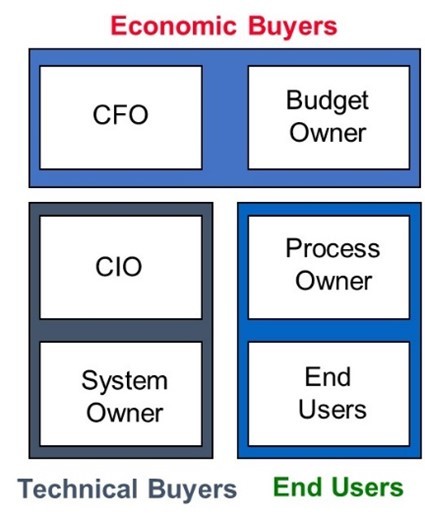
GUEST POST from Geoffrey A. Moore
Like everything else in this Darwinian world of ours, customer journeys evolve with changes in the environment. Ever since the advent of the semiconductor, a compelling source of such changes has been disruptive digital technology. Although we are all eager to embrace its benefits, markets must first work through their adoption life cycles, during which different buying personas come to the fore at different stages, with each one on a very different kind of journey.
So, if you plan to catch the next wave and sell the next big thing, you’re going to need to adjust your customer journey playbook as you go along. Here’s a recap of what is in store for you.
Customer Journeys in the Early Market
The early market buying personas are the visionary and the technology enthusiast, the former eager to leverage disruption to gain first-mover competitive advantage, the latter excited to participate in the latest and greatest thing. Both are on a journey of discovery.
Technology enthusiasts need to get as close to the product as possible, seeing demos and alpha-testing prototypes as soon as they are released. They are not looking to be sold (for one thing, they have no money)—they are looking to educate themselves in order to be a reliable advisor to their visionary colleague. The key is to garner them privileged access to the technical whizzes in your own enterprise and, once under NDA, to share with them the wondrous roadmap you have in mind.
Visionaries are on a different path. They want to get as clear an understanding as possible of what makes the disruptive technology so different, to see whether such a difference could be a game changer in their circumstances. This is an exercise in imagineering. It will involve discussing hypothetical use cases, and applying first principles, which means you need to bring the smartest people in your company to the table, people who can not only communicate the magic of what you have but who can also keep up with the visionary’s vision as well.
Once this journey is started, you need to guide it toward a project, not a product sale. It is simply too early to make any kind of product promise that you can reliably keep. Not only is the paint not yet dry on your own offer, but also the partner ecosystem is as yet non-existent, so the only way a whole product can be delivered is via a dedicated project team. To up the stakes even further, visionaries aren’t interested in any normal productivity improvements, they are looking to leapfrog the competition with something astounding, so a huge amount of custom work will be required. This is all well and good provided you have a project-centric contract that doesn’t leave you on the hook for all the extra labor involved.
Customer Journeys to Cross the Chasm
The buying personas on the other side of the chasm are neither visionaries nor technology enthusiasts. Rather, they are pragmatists, and to be really specific, they are pragmatists in pain. Unlike early market customers, they are not trying to get ahead, they are trying to get themselves out of a jam. In such a state, they could care less about your product, and they do not want to meet your engineers or engage in any pie-in-the-sky discussions of what the future may hold. All they want to do is find a way out of their pain.
This is a journey of diagnosis and prescription. They have a problem which, given conventional remedies, is not really solvable. They are making do with patchwork solutions, but the overall situation is deteriorating, and they know they need help. Sadly, their incumbent vendors are not able to provide it, so despite their normal pragmatist hesitation about committing to a vendor they don’t know and a solution that has yet to be proven, they are willing to take a chance—provided, that is, that:
- you demonstrate that you understand their problem in sufficient depth to be credible as a solution provider, and
- that you commit to bringing the entire solution to the table, even when it involves orchestrating with partners to do so.
To do so, your first job is to engage with the owner of the problem process in a dialog about what is going on. During these conversations, you demonstrate your credibility by anticipating the prospective customer’s issues and referencing other customers who have faced similar challenges. Once prospects have assured themselves that you appreciate the magnitude of their problem and that you have expertise to address its challenges, then (and only then) will they want to hear about your products and services.
As the vendor, therefore, you are differentiating on experience and domain expertise, ideally by bringing someone to the table who has worked in the target market segment and walked in your prospective customer’s shoes. Once you have established credibility by so doing, then you must show how you have positioned the full force of your disruptive product to address the very problem that besets your target market. Of course, you know that your product is far more capable than this, and you also know you have promised your investors global domination, not a niche market solution. But for right now, to cross the chasm, you forsake all that and become laser-focused on demolishing the problem at hand. Do that for the first customer, and they will tell others. Do that for the next, and they will tell more. By the time you have done this four or five times, your phone will start ringing. But to get to this point, you need to be customer-led, not product-led.
Customer Journeys Inside the Tornado.
The tornado is that point in the technology adoption life cycle when the pragmatist community shifts from fear of going too soon to fear of missing out. As a consequence, they all rush to catch up. Even without a compelling first use case, they commit resources to the new category. Thus, for the first time in the history of the category, prospective customers have budget allocated before the salesperson calls. (In the early market, there was no budget at all—the visionary had to create it. In the chasm-crossing scenario, there is budget, but it is being spent on patchwork fixes with legacy solutions and needs to get reallocated before a deal can be closed.)
Budget is allocated to the department that will purchase and support the new offer, not the ones who will actually use it (although they will no doubt get chargebacks at some point). That means for IT offerings the target customer is the technical buyer and the CIO, the former who will make the product decision, the latter who will make the vendor decision. Ideally, the two will coincide, but when they don’t, the vendor choice usually prevails.
Now, one thing we know about budgets is that once they have been allocated they will get spent. These customers are on a buying mission journey. They produce RFPs to let them compare products and vet companies, and they don’t want any vendor to get too close to them during the process. Sales cycles are super-competitive, and product bake-offs are not uncommon. This means you need to bring your best systems engineers to the table, armed with killer demos, supported by sales teams, armed with battle cards that highlight competitor strengths and weaknesses and how to cope with the former and exploit the latter. There is no customer intimacy involved.
What is at stake, instead, is simply winning the deal. Here account mapping can make a big difference. Who is the decision maker really? Who are the influencers? Who has the inside track? You need a champion on the inside who can give you the real scoop. And at the end of the sales cycle, you can expect a major objection to your proposal, a real potential showstopper, where you will have to find some very creative way to close the deal and get it off the table. That is how market share battles are won.
Customer Journeys on Main Street
On Main Street, you are either the incumbent or a challenger. If the latter, your best bet is to follow a variation on the chasm-crossing playbook, searching out a use case where the incumbent is not well positioned and the process owner is getting frustrated—as discussed above. For incumbents, on the other hand, it is a completely different playbook.
The persona that matters most on Main Street is the end user, regardless of whether they have budget or buying authority. Increasing their productivity is what creates the ROI that justifies any additional purchases, not to mention retaining the current subscription. This calls for a journey of continuous improvement.
Such a journey rewards two value disciplines on the vendor’s part—customer intimacy and operational excellence. The first is much aided by the advent of telemetry which can track product usage by user and identify opportunities for improvement. Telemetric data can feed a customer health score which allows the support team to see where additional attention is most needed. Supplying the attention requires operational excellence, and once again technology innovation is changing the game, this time through product-led prompts, now amplified by generative AI commentary. Finally, sitting atop such infrastructure is the increasingly powerful customer success function whose role is to connect with the middle management in charge, discuss with them current health score issues and their remediation, and explore opportunities for adding users, incorporating product extensions, and automating adjacent use cases.
Summing up
The whole point of customer journeys done right is to start with the customer, not with the sales plan. That said, where the customer is in their adoption life cycle defines the kind of journey they are most likely to be on. One size does not fit all, so it behooves the account team to place its bets as best it can and then course correct from there.
That’s what I think. What do you think?
Image Credit: Pixabay
 Sign up here to join 17,000+ leaders getting Human-Centered Change & Innovation Weekly delivered to their inbox every week.
Sign up here to join 17,000+ leaders getting Human-Centered Change & Innovation Weekly delivered to their inbox every week.

![]() Sign up here to join 17,000+ leaders getting Human-Centered Change & Innovation Weekly delivered to their inbox every week.
Sign up here to join 17,000+ leaders getting Human-Centered Change & Innovation Weekly delivered to their inbox every week.










